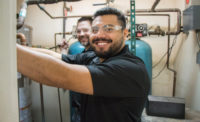I thoroughly enjoyed Howard McKew’s article – “Leaving a Legacy” (September 2014) – in the latest edition of Engineered Systems.
I have three very special engineers that have left a legacy with me during my HVAC engineering career.
The first one is Fred Taylor P.E., the original principal at Taylor Systems Engineering, Inc. Fred was an excellent mechanical engineer and an outstanding boss. Fred hired me as a hand drafter right out of my college days in 1981, way back before CAD was even practical for the small engineering office. Fred was a natural-born teacher and he had high expectations for everyone that he employed. In fact, when he first hired me, he said that he did not expect me to be a “drafter” in five years, that he expected me to become an HVAC designer. With Fred’s encouragement, I set my sights on becoming an engineer and was able to work my way up from drafter to designer to engineer to a licensed Professional Engineer. It would have been a very difficult journey without his help and encouragement.
The second gentleman is Cliff Gustafson, P.E., the current principal of Taylor Systems Engineering. When Cliff took over from Fred, he continued the traditions that Fred had started. He continued to expect high standards from all his employees while encouraging them to reach their full potential. I was in the Air Force Reserve while working for Cliff, and he supported me when I was activated (twice for a total of two years of service) after 9/11. Cliff went above and beyond what he needed to do and was there for me and my family after I returned to civilian life after retiring from the Air Force Reserve.
The gentleman that is currently my boss, Harold Hougham of R&A Engineering Solutions, Inc., is also leaving a great legacy in our field. After the economic downturn in 2010 forced my leaving TSE, Harold was able to pick me up as an engineer, one starting in a new variation of my HVAC engineering career. The health care industry in California is a very regulated industry and has unique regulations like no other state in our country. With Harold’s encouragement, I have been able to expand my experience in the healthcare field.
All three of these gentlemen have left their mark on my career. I hope that in dealing with my fellow engineers, designers, architects, and clients, I am able to pass on some of what these gentlemen have taught me.
Wayne Watts, P.E.
Mechanical Engineer
Sacramento, CA
McKew responds:
Thank you for taking the time to share your experience with a select few people who have truly mattered in your professional life. Hopefully, we will hear from others who want to share the legacy of those who have mentored and contributed to this great HVAC industry.
When Piping Meets Electrical
Mr. McKew — I always look forward to reading your articles in Engineered Systems and I am listing you as my top choice for the mechanical engineer who has left a legacy with me. I have never met you, but after reading many of your articles, I wish I would have the pleasure of working on one of the projects that you had designed.
I am retired but started out as a foreman and assisted in an HVAC design and build department and finished my career as a project manager. At present, I do teach a course to the local apprentices at LU 449 in Pittsburgh.
We review MER contract design drawings and start a coordination process and use all of your suggestions for a MER room as you listed in your articles. We have a checklist we use to compare the contract bid drawings to see if there are any code issues.
You would be surprised how often the boilers do not meet the PA Boiler Law for the proper clearances. Also, the contract MER drawing that we are reviewing has chilled water piping passing over top of electrical switch gear and transformers and finally through a generator room to exit out of the building to connect to a chiller that is located outside of the building.
Something I was hoping you could help us with, or better yet write an article on, is locating water piping over electrical equipment. I do understand this is not allowed per NEC, and we do relocate the piping out of the dedicated space for this electrical equipment.
However, I can’t find any good information regarding whether you can pass water piping through an electrical room, generator room, or elevator equipment room. We do see contract drawings that have piping passing thought these rooms and always try to relocate the piping. But the question is, does this water piping passing though these rooms violate any NEC codes? The answers on the internet are not conclusive, and we were hoping you could provide some information regarding this issue.
Thank you —
Don Himber
Evans City, PA
McKew responds:
Thank you for taking the time to email me, and I appreciate your kind comments relative to leaving a legacy. I do believe we may have shared a couple of emails in the past pertaining to your own initiative to teach students about HVAC in addition to your current teaching apprentice.
I will get back to you with my thoughts on water pipes in the area of electricity and whether it violates NEC code (which I believe is stated in there somewhere).
Thank you for the idea of creating a checklist for chilled water distribution. I wrote about designing a chiller room in June 2013 in this column, followed by central boiler rooms and then fan rooms, so I’ll go back and see what I can write that could become a checklist in the future.




